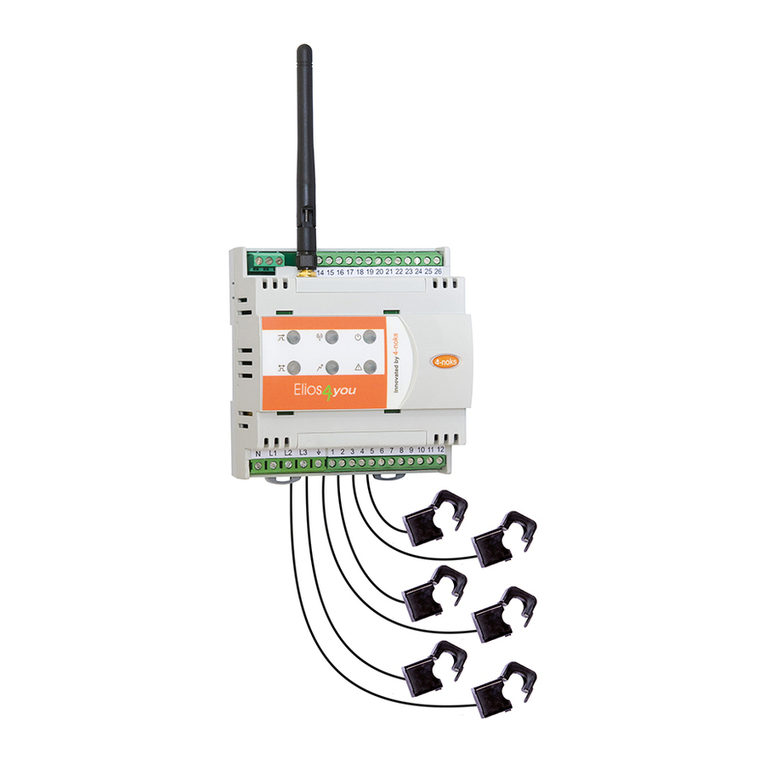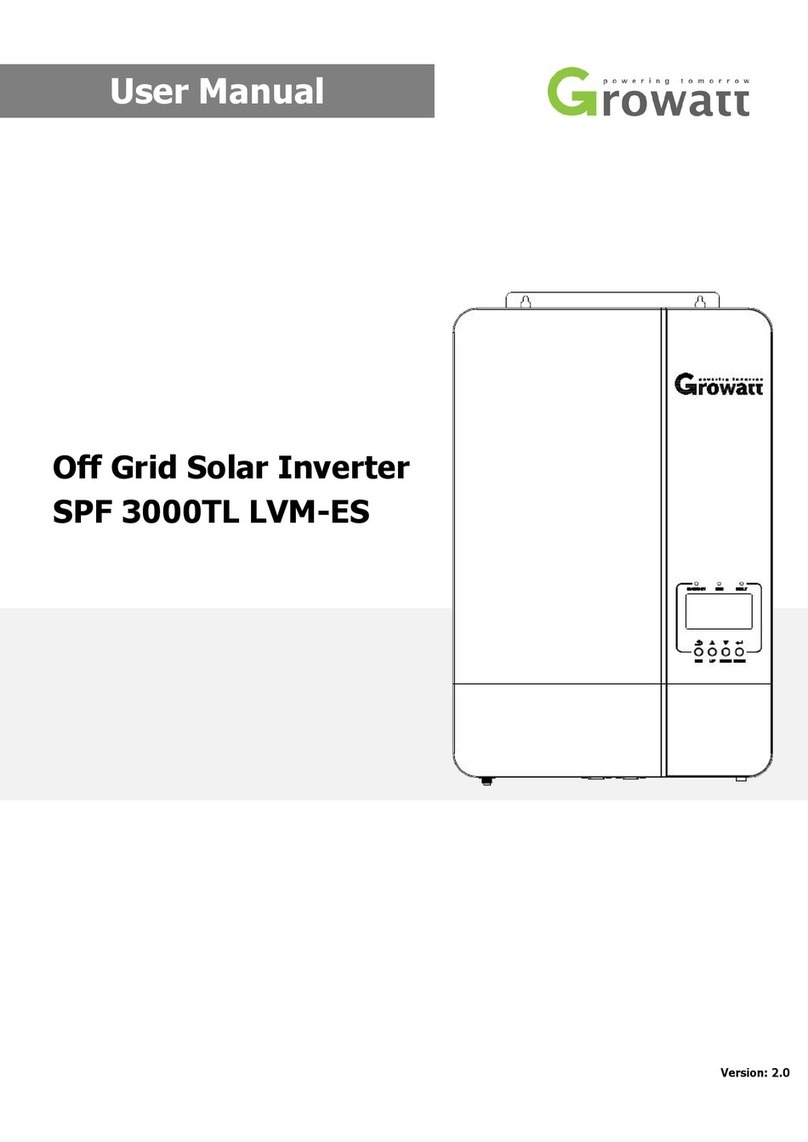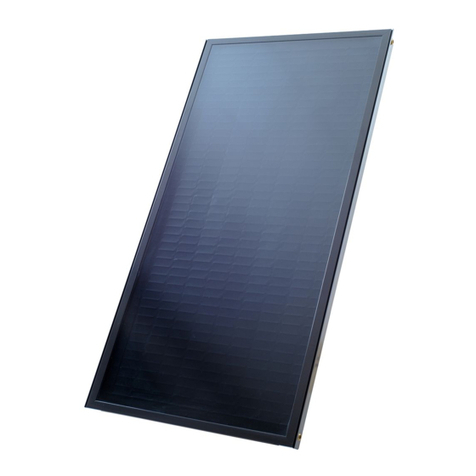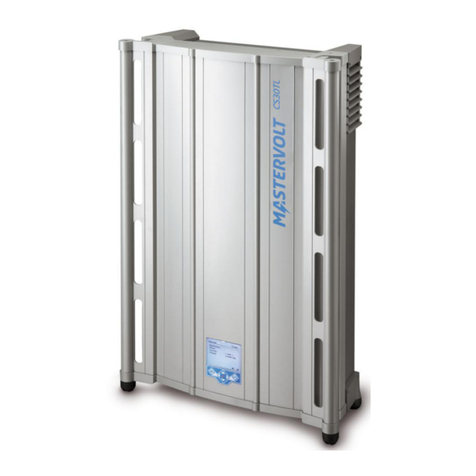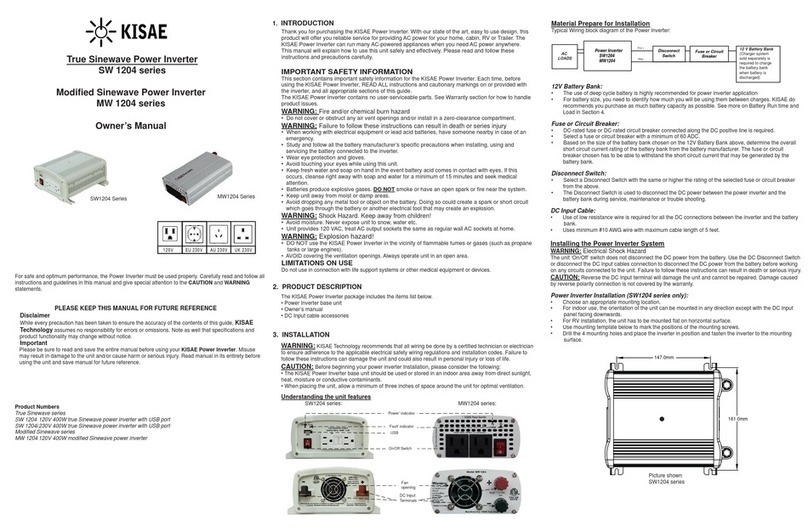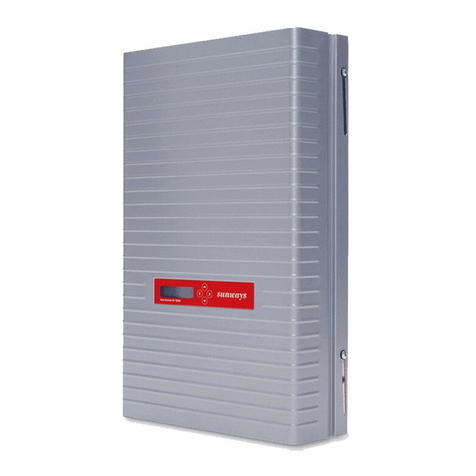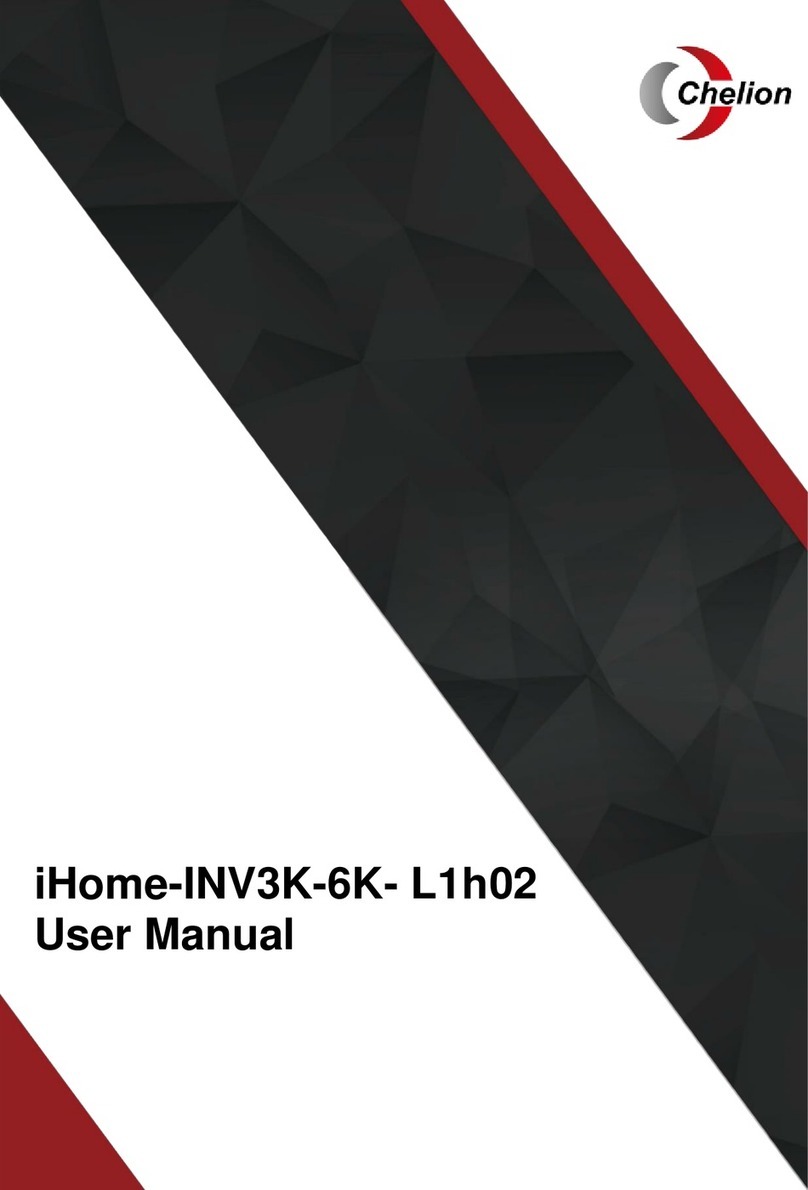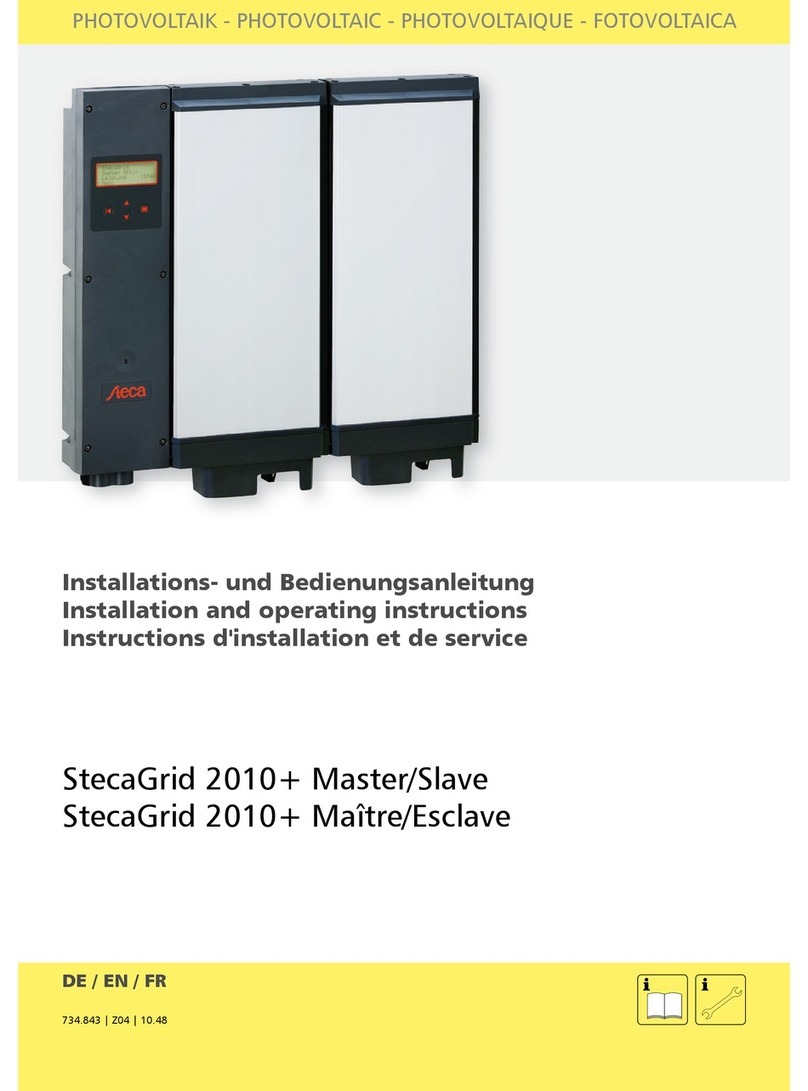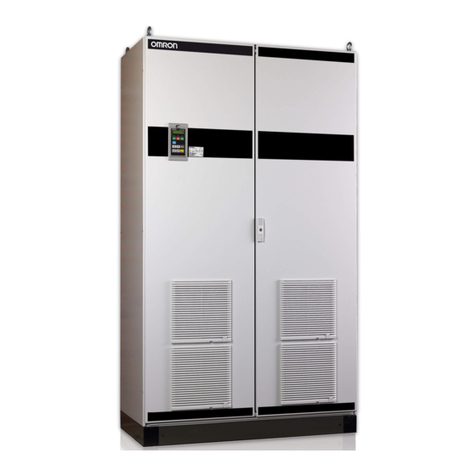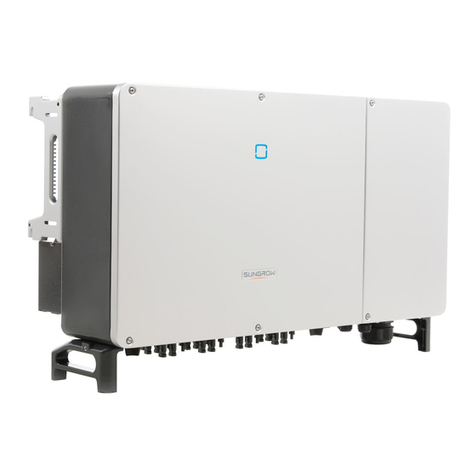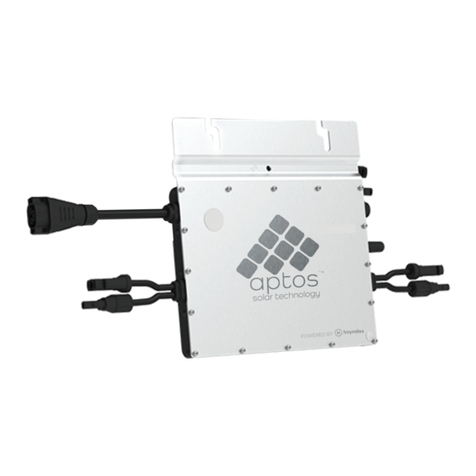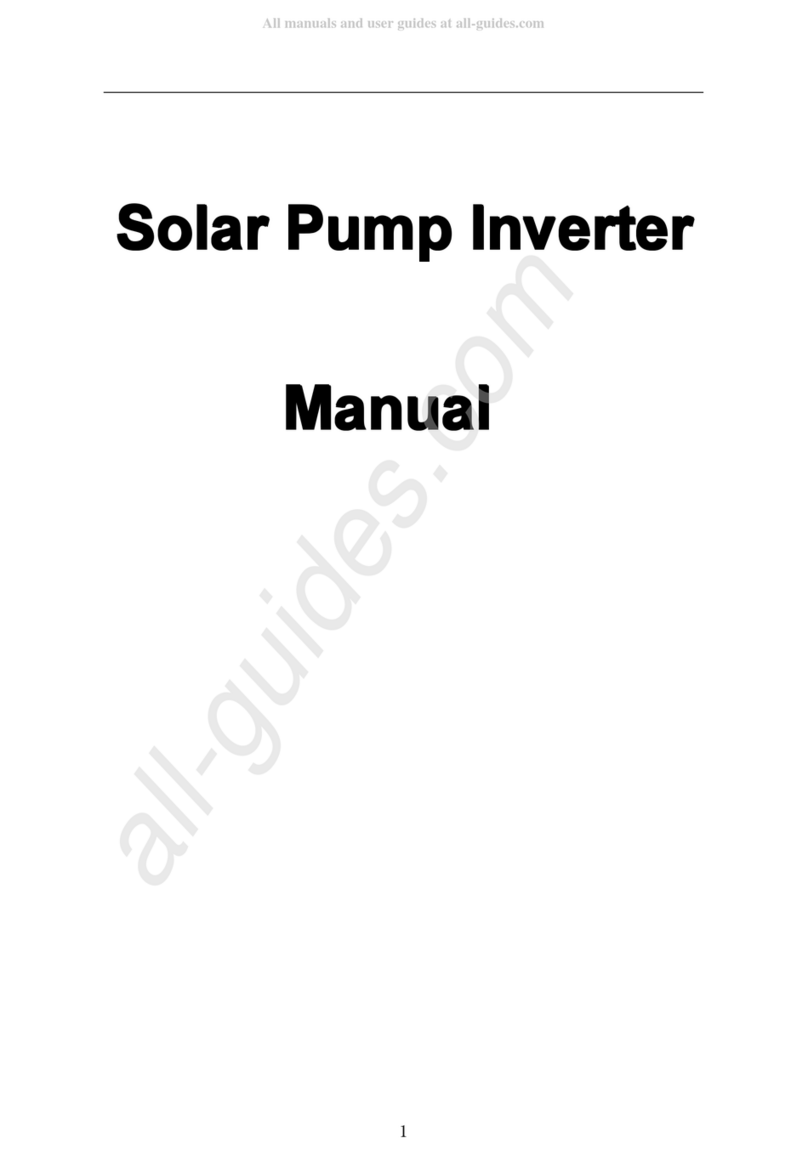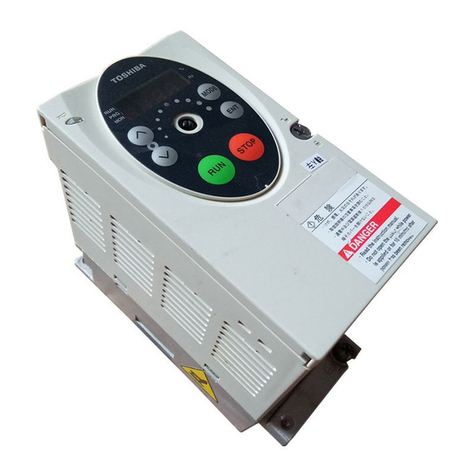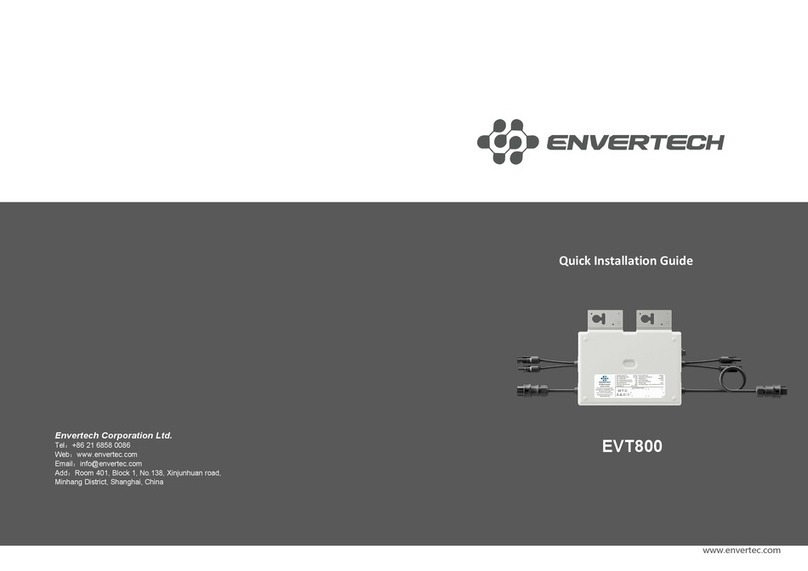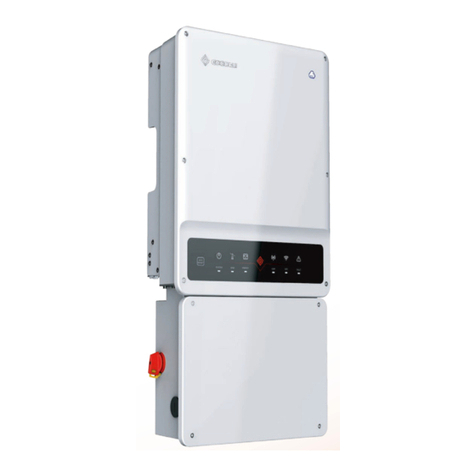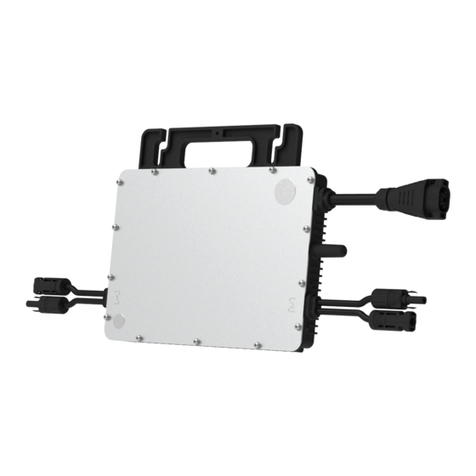Miki Pulley V6 series User manual

Instruction Manual
Compact Inverter
V6 series
Thank you for purchasing our V6 series of inverters.
• This product is designed to drive a three-phase induction motor. Read through this instruction
manual and be familiar with the handling procedure for correct use.
• Improper handling might result in incorrect operation, a short life, or even a failure of this
product as well as the motor.
• Deliver this manual to the end user of this product. Keep this manual in a safe place until this
product is discarded.
• For how to use an optional device, refer to the instruction and installation manuals for that
optional device.
Miki Pulley Co., Ltd. TRS-IV-008
[ IBD#D-I-25-B ]

i
Preface
Thank you for purchasing our V6 series of inverters.
This product is designed to drive a three-phase induction motor. Read through this instruction
manual and be familiar with proper handling and operation of this product.
Improper handling might result in incorrect operation, a short life, or even a failure of this product as
well as the motor.
Have this manual delivered to the end userof this product. Keep this manual in a safe place untilthis
product is discarded.
The materials are subject to change without notice. Be sure to obtain the latest editions for use.
Japanese Guideline for Suppressing Harmonics in Home Electric and
General-purpose Appliances
Three-phase, 200 V series inverters of 3.7 (4.0) kW or less are the products specified in the
"Japanese Guideline for Suppressing Harmonics in Home Electric and General-purpose
Appliances" (established in September 1994 and revised in October 1999), published by the Ministry
of International Trade and Industry (currently the Ministry of Economy, Trade and Industry (METI)).
The Japan Electrical Manufacturers' Association (JEMA) has established a standard of regulation
levels based on this guideline. To meet this standard, a reactor (for harmonic suppression) must be
connected to an inverter. It is recommended that you use one of the DC reactors listed in this manual.
If you choose to prepare a reactor other than the ones listed, however, it is suggested that you
consult your representative for the specifications.
Safety precautions
Read this manual thoroughly before proceeding with installation, connections (wiring), operation, or
maintenance and inspection. Ensure you have sound knowledge of the device and familiarize
yourself with all safety information and precautions before proceeding to operate the inverter.
Safety precautions are classified into the following two categories in this manual.
Failure to heed the information indicated by this symbol may
lead to dangerous conditions, possibly resulting in death or
serious bodily injuries.
Failure to heed the information indicated by this symbol may
lead to dangerous conditions, possibly resulting in minor or
light bodily injuries and/or substantial property damage.
Failure to heed the information contained under the CAUTION title can also result in serious
consequences. These safety precautions are of utmost importance and must be observed at all
times.
Application
• V6 series is designed to drive a three-phase induction motor. Do not use it for
single-phase motors or for other purposes.

ii
Fire or an accident could occur.
• V6 series may not be used for a life-support system or other purposes directly related to
the human safety.
• Though V6 series is manufactured under strict quality control, install safety devices for
applications where serious accidents or material losses are foreseen in relation to the
failure of it.
An accident could occur.
Installation
• Install the inverter on a nonflammable material such as metal.
Otherwise fire could occur.
• Do not place flammable matter nearby.
Doing so could cause fire.
• Do not support the inverter by its terminal block cover during transportation.
Doing so could cause a drop of the inverter and injuries.
• Prevent lint, paper fibers, sawdust, dust, metallic chips, or other foreign materials from
getting into the inverter or from accumulating on the heat sink.
Otherwise, a fire or an accident might result.
• Do not install or operate an inverter that is damaged or lacking parts.
Doing so could cause fire, an accident or injuries.
• Do not get on a shipping box.
• Do not stack shipping boxes higher thanthe indicated information printed onthose boxes.
Doing so could cause injuries.
Wiring
• When wiring the inverter to the power source, insert a recommended molded case circuit
breaker (MCCB) or residual-current-operated protective device (RCD)/earth leakage
circuit breaker (ELCB) (with overcurrent protection) in the path of power lines. Use the
devices within the recommended current range.
• Use wires in the specified size.
Otherwise, fire could occur.
• Do not use one multicore cable in order to connect several inverters with motors.
• Do not connect a surge killer to the inverter's output (secondary) circuit.
Doing so could cause fire.
• Be sure to connect the grounding wires without fail.

iii
Otherwise, electric shock or fire could occur.
• Qualified electricians should carry out wiring.
• Be sure to perform wiring after turning the power off.
• Ground the inverter following Class C or Class D specifications or national/local electric
code, depending on the input voltage of the inverter.
Otherwise, electric shock could occur.
• Be sure to perform wiring after installing the inverter body.
Otherwise, electric shock or injuries could occur.
• Ensure that the number of input phases and the rated voltage of the product match the
number of phases and the voltage of the AC power supply to which the product is to be
connected.
Otherwise fire or an accident could occur.
• Do not connect the power source wires to output terminals (U, V, and W).
• Do not insert a braking resistor between terminals P (+) and N (-), P1 and N (-), P (+) and
P1, DB and N (-), or P1 and DB.
Doing so could cause fire or an accident.
• Wire the three-phase motor to terminals U, V, and W of the inverter, aligning phases each
other.
Otherwise injuries could occur.
• The inverter, motor and wiring generate electric noise. Take care of malfunction of the
nearby sensors and devices. To prevent the motor from malfunctioning, implement noise
control measures.
Otherwise an accident could occur.
Operation
Be sure to install the terminal block cover before turning the power on. Do not remove the
cover while power is applied.
Otherwise electric shock could occur.
• Do not operate switches with wet hands.
Doing so could cause electric shock.
• If the retry functionhas been selected, the inverter may automaticallyrestart and drive the
motor depending on the cause of tripping.
(Design the machinery or equipment so that human safety is ensured after restarting.)
• If the stall prevention function (current limiter), automatic deceleration, and overload
prevention control have been selected, the inverter may operate at an
acceleration/deceleration time or frequency different from the set ones. Design the
machine so that safety is ensured even in such cases.
Otherwise an accident could occur.

iv
• The STOP key is only effective when function setting (Function code F02) has been
established to enable the STOPkey. Prepare an emergency stop switch separately. If you
disable the STOP key priority function and enable operation by external commands, you
cannot emergency-stop the inverter using the STOP key on the built-in keypad.
• If an alarm reset is made with the operation signal turned on, a sudden start will occur.
Ensure that the operation signal is turned off in advance.
Otherwise an accident could occur.
• If you enable the "restart mode after instantaneous power failure" (Function code F14 = 4
or 5), then the inverter automatically restarts running the motor when the power is
recovered.
(Design the machinery or equipment so that human safety is ensured after restarting.)
• If you set the function codes wrongly or without completely understanding this instruction
manual, the motor may rotate with a torque or at a speed not permitted for the machine.
An accident or injuries could occur.
• Do not touch the inverter terminals while the power is applied to the inverter even if the
inverter stops.
Doing so could cause electric shock.
• Do not turn the main circuit power on or off in order to start or stop inverter operation.
Doing so could cause failure.
• Do not touch the heat sink or braking resistor because they become very hot.
Doing so could cause burns.
• Setting the inverter to high speeds is easy. Before changing the frequency (speed) setting,
check the specifications of the motor and machinery.
• The brake function of the inverter does not provide mechanical holding means.
Injuries could occur.
Installation and wiring of an option card
• Before installing an RS485 Communications Card, turn off the power, wait more than five
minutes, and make sure, using a circuit tester or a similar instrument, that the DC link
circuit voltage between the terminals P (+) and N (-) has dropped below a safe voltage
(+25 VDC).
• Do not remove the terminal cover for the control circuits while power is applied, because
high voltage lines exist on the RS485 Communications Card.
Failure to observe these precautions could cause electric shock.
• In general, sheaths and covers of the control signal cables and wires are not specifically
designed to withstand a high electric field (i.e., reinforced insulation is not applied).
Therefore, if a control signal cable or wire comes into direct contact with a live conductor of
the main circuit, the insulation of the sheath or the cover might break down, which would
ex
p
ose the si
g
nal wire to a hi
g
h volta
g
e of the main circuit. Make sure that the control

v
signal cables and wires will not come into contact with live conductors of the main circuits.
Failure to observe these precautions could cause electric shock and/or an
accident.
Maintenance and inspection, and parts replacement
• Turn the power off and wait for at least five minutes before starting inspection. Further,
check that the LED monitor is unlit, and check the DC link circuit voltage between the P(+)
and N (-) terminals to be lower than 25 VDC.
Otherwise, electric shock could occur.
• Maintenance, inspection, and parts replacement should be made only by qualified
persons.
• Take off the watch, rings and other metallic matter before starting work.
• Use insulated tools.
Otherwise, electric shock or injuries could occur.
Disposal
• Handle the inverter as an industrial waste when disposing of it.
Otherwise injuries could occur.
Others
• Never attempt to modify the inverter.
Doing so could cause electric shock or injuries.
GENERAL PRECAUTIONS
Drawings in this manual may be illustrated without covers or safety shields for explanation of
detail parts. Restore the covers and shields in the original state and observe the description in
the manual before starting operation.
Conformity to the Low Voltage Directive in the EU
If installed according to the guidelinesgiven below, inverters marked with CE or TÜV are considered
as compliant with the Low Voltage Directive 73/23/EEC.
1. The ground terminal G should always be connected to the ground. Do not use only a
residual-current-operated protective device (RCD)/earth leakage circuit breaker (ELCB)* as
the sole method of electric shock
p
rotection. Be sure to use
g
round wires whose size is

vi
greater than power supply lines.
*With overcurrent protection.
2. When used with the inverter, a molded case circuit breaker (MCCB),
residual-current-operated protective device (RCD)/earth leakage circuit breaker (ELCB) or
magnetic contactor (MC) should conform to the EN or IEC standards.
3. When you use a residual-current-operated protective device (RCD)/earth leakage circuit
breaker (ELCB) for protection from electric shock in direct or indirect contact power lines or
nodes, be sure to install type B of RCD/ELCB on the input (primary) of the inverter if the
power source is three-phase 200/400 V. For single-phase 200 V power supplies, use type
A.
When you use no RCD/ELCB, take any other protective measure that isolates the electric
equipment from other equipment on the same power supply line using double or reinforced
insulation or that isolates the power supply lines connected to the electric equipment using
an isolation transformer.
4. The inverter should be used in an environment that does not exceed Pollution Degree 2
requirements. If the environment conforms to Pollution Degree 3 or 4, install the inverter in
an enclosure of IP54 or higher.
5. Install the inverter, AC or DC reactor, input or output filter in an enclosure with minimum
degree of protection of IP2X (Top surface of enclosure shall be minimum IP4X when it can
be easily accessed), to prevent human body from touching directly to live parts of these
equipment.
6. To make an inverter with no integrated EMC filter conform to the EMC directive, it is
necessary to connect an external EMC filter to the inverter and install them properly so that
the entire equipment including the inverter conforms to the EMC directive.
7. Do not connect any copper wire directly to grounding terminals. Use crimp terminals with tin
or equivalent plating to connect them.
8. To connect the three-phase orsingle-phase 200 V series of inverters to the power supply in
Overvoltage Category III or to connect the 3-phase 400 V series of inverters to the power
supply in Overvoltage Category II or III, a supplementary insulation is required for the
control circuitry.
9. When you use an inverter at an altitude of more than 2000 m, you should apply basic
insulation for the control circuits of the inverter. The inverter cannot be used at altitudes of
more than 3000 m.
10. The power supply mains neutral has to be earthed for the three-phase 400 V class inverter.

vii
Conformity to the Low Voltage Directive in the EU (Continued)
11. Use wires listed in EN60204 Appendix C.
MCCB: Molded case circuit breaker
RCD: Residual-current-operated protective device
ELCB: Earth leakage circuit breaker
*1 The frame size and model of the MCCB or RCD/ELCB (with overcurrent protection) will vary,
depending on the power transformer capacity. Refer to the related technical documentation for
details.
*2 The recommended wire size for main circuits is for the 70°C 600V PVC wires used at an ambient
temperature of 40°C.
*3 In the case of no DC reactor, the wire sizes are determined on the basis of the effective input
current calculated under the condition that the power supply capacity and impedance are 500 kVA
and 5%, respectively.
Recommended wire size (mm2 )
*1
Rated current (A)
of
MCCB or RCD/ELCB
*2
Main circuit
power input
[L1/R, L2/S, L3/T]
[L1/L, L2/N]
Grounding [ G]
Power supply voltage
Appli-
cable
motor
rating
(kW)
Inverter type
w/ DCR *3
w/o DCR
w/ DCR *3
w/o DCR
*2
Inverte
r output
[U, V,
W]
*2
DCR
[P1,
P (+)]
Braking
resistor
[P (+),
DB]
Control
circuit
(30A,
30B,
30C)
0.1 V6-01-4
0.2 V6-02-4
0.4 V6-04-4
6
0.75 V6-07-4
6
10
1.5 V6-15-3 16
2.2 V6-22-3 10 20
2.5 2.5
Three-phase 200 V
3.7 V6-37-3 20 35
2.5
4 4
2.5 0.5

viii
Conformity to UL standards and Canadian standards (cUL certification)
If installed according to the guidelines given below, inverters marked with UL/cULare considered as
compliant with the UL and CSA (cUL certified) standards.
1. Solid state motor overload protection (motor protection by electronic thermal overload relay)
is provided in each model.
Use function codes F10 to F12 to set the protection level.
2. Connect the power supply satisfying the characteristics shown in the table belowas an input
power supply of the inverter.(Short circuit rating)
3. Use 75°C Cu wire only.
4. Use Class 1 wire only for control circuits.
5. Field wiring connection must be made by a UL Listed and CSA Certified closed-loop terminal
connector sized for the wire gauge involved. Connector must be fixed using the crimp tool
specified by the connector manufacturer.
Short circuit rating
Suitable for use on a circuit capable of delivering not more than B rms symmetrical amperes, A
volts maximum.
Power
supply
voltage Inverter type Power supply max. voltage A Power supply current B
V6-01-4
V6-02-4
V6-04-4
V6-07-4
V6-15-3
V6-22-3
Three-
phase
200V
V6-37-3
240 VAC 100,000 A or less

ix
Conformity to UL standards and Canadian standards (cUL certification) (Continued)
6. Install UL certified fuses between the power supply and the inverter, referring to the table
below.
*1: Denotes the relay contact terminals for 30A, 30B and 30C.
*2: Denotes control terminals except for 30A, 30B and 30C.
Required torque
Ib-in (N·m) Wire size
AWG or kcmil (mm2)
Control circuit Control circuit
Power
supply
voltage Inverter type
Main
terminal *1
TERM1
*2
TERM2-1
TERM2-2
Main
terminal *1
TERM1
*2
TERM2-1
TERM2-2
Class J fuse
current (A)
V6-01-4 3
V6-02-4 6
V6-04-4 10
V6-07-4
10.6
(1.2)
15
V6-15-3 20
V6-22-3
14
30
Three-phase
200V
V6-37-3
15.9
(1.8)
3.5
(0.4) 1.8
(0.2)
10
20
(0.5)
40

x
Precautions for use
Torque
characteristics
and temperature
rise
When the inverter isused to run a general-purpose motor, the
temperature of the motor becomes higher than when it is
operated using a commercial power supply. In the low-speed
range, the cooling effect will be weakened, so decrease the
output torque of the motor. If constant torque is required in
the low-speed range, use a inverter motor or a motor
equipped with an externally powered ventilating fan.
Vibration
When an inverter-driven motor is mounted to a machine,
resonance may be caused by the natural frequencies of the
machine system.
Note that operation of a 2-pole motor at 60 Hz or higher may
cause abnormal vibration.
* The use of a rubber coupling or vibration dampening rubber
is recommended.
* Use the inverter's jump frequency control feature to skip
the resonance frequency zone(s).
In running
general-
purpose
motors
Noise
When an inverter is used with a general-purpose motor, the
motor noise level is higherthan that with a commercial power
supply. To reduce noise, raise carrier frequency of the
inverter. Operation at 60 Hz or higher can alsoresult in higher
noise level.
High-speed
motors If the set frequency is set to 120 Hz or more to drive a
high-speed motor, test-run the combination of the inverter
and motor beforehand to check for safe operation.
Explosion-proof
motors When driving an explosion-proof motor with an inverter, use a
combination of a motor and an inverter that has been
approved in advance.
Submersible
motors and
pumps
These motors have a larger rated current than
general-purpose motors. Select an inverter whose rated
output current is greater than that of the motor.
These motors differ from general-purpose motors in thermal
characteristics. Set a low value in the thermal time constant
of the motor when setting the electronic thermal function.
Brake motors
For motors equipped with parallel-connected brakes, their
braking power must be supplied from the primary circuit. If
the brake power is connected to the inverter's power output
circuit by mistake, the brake will not work.
Do not use inverters for driving motors equipped with
series-connected brakes.
Geared motors If the power transmission mechanism uses an oil-lubricated
gearbox or speed changer/reducer, then continuous motor
operation at low speed may cause poor lubrication. Avoid
such operation.
In running
special
motors
Synchronous
motors It is necessary to take special measures suitable for this
motor type. Contact your Miki Pulley representative for
details.

xi
In running
special
motors
Single-phase
motors
Single-phase motors are not suitable for inverter-driven
variable speed operation. Use three-phase motors.
* Even if a single-phase power supply is available, use a
three-phase motor as the inverter provides three-phase
output.
Environ-
mental
conditions
Installation
location
Use the inverter within the ambient temperature range from
-10 to +50°C.
The heat sink and braking resistor of the inverter may
become hot under certain operating conditions, so install the
inverter on nonflammable material such as metal.
Ensure that the installation location meets the environmental
conditions specified in Chapter 2, Section 2.1 "Operating
Environment."
Installing an
MCCB or
RCD/ELCB
Install a recommended molded case circuit breaker (MCCB)
or residual-current-operated protective device (RCD)/earth
leakage circuit breaker (ELCB) (with overcurrent protection)
in the primary circuit of the inverter to protect the wiring.
Ensure that the circuit breaker capacity is equivalent to or
lower than the recommended capacity.
Installing an MC
in the secondary
circuit
If a magnetic contactor (MC) is mounted in the inverter's
secondary circuit for switching the motor to commercial
power or for any other purpose, ensure that both the inverter
and the motor are completelystopped before you turn the MC
on or off.
Do not connect a magnet contactor united with a surge killer
to the inverter's secondary circuit.
Installing an MC
in the primary
circuit
Do not turn the magneticcontactor (MC) inthe primary circuit
on or off more than once an hour as an inverter failure may
result.
If frequent starts or stops are required during motor
operation, use FWD/REV signals or the RUN/STOP key.
Protecting the
motor
The electronic thermal function of the inverter can protect the
motor. The operation level and the motor type
(general-purpose motor, inverter motor) should be set. For
high-speed motors or water-cooled motors, set a small value
for the thermal time constant and protect the motor.
If you connect the motor thermal relay to the motor with a
long wire, a high-frequency current may flow into the wiring
stray capacitance. This may cause the relay to trip at a
current lower than the set value for the thermal relay. If this
happens, lower the carrier frequency or use the output circuit
filter (OFL).
Discontinuance
of power-factor
correcting
capacitor
Do not mount power-factor correcting capacitors in the
inverter’s primary circuit. (Use the DC reactor to improve the
inverter power factor.) Do not use power-factor correcting
capacitors in the inverter output circuit. An overcurrent trip
will occur, disabling motor operation.
Combina-
tion with
peripheral
devices
Discontinuance
of surge killer Do not connect a surge killer to the inverter's secondary
circuit.

xii
Reducing noise Use of a filter andshielded wires is typicallyrecommended to
satisfy EMC directives.
Measures against
surge currents
If an overvoltage trip occurs while the inverter is stopped or
operated under a light load, it is assumed that the surge
current is generated by open/close of the phase-advancing
capacitor in the power system.
* Connect a DC reactor to the inverter.
Combina-
tion with
peripheral
devices
Megger test When checking the insulation resistance of the inverter, use a
500 V megger and follow the instructions contained in
Chapter 7, Section 7.4 "Insulation Test."
Control circuit
wiring length
When using remote control, limit the wiring length between
the inverter and operator box to 20 m or less and use twisted
pair or shielded cable.
Wiring length
between inverter
and motor
If long wiring is used between the inverter and the motor, the
inverter will overheat or trip as a result of overcurrent
(high-frequency current flowing into the stray capacitance) in
the wires connected to the phases. Ensure that the wiring is
shorter than 50 m. If this length must be exceeded, lower the
carrier frequency or mount an output circuit filter (OFL).
Wiring size Select wires with a sufficient capacity by referring to the
current value or recommended wire size.
Wiring type Do not use one multicore cable in order to connect several
inverters with motors.
Wiring
Grounding Securely ground the inverter using the grounding terminal.
Driving
general-purpose
motor
Select an inverter according to the applicable motor ratings
listed in the standard specifications table for the inverter.
When high starting torque is required or quick acceleration or
deceleration is required, select an inverter with a capacity
one size greater than the standard.
Selecting
inverter
capacity
Driving special
motors Select an inverter that meets the following condition:
Inverter rated current > Motor rated current
Transpor-
tation and
storage
When transporting or storing inverters, follow the procedures and select locations
that meet the environmental conditions listed in Chapter 1, Section 1.3
"Transportation" and Section 1.4 "Storage Environment."

xiii
How this manual is organized
This manual is made up of chapters 1 through 11.
Chapter 1 BEFORE USING THE INVERTER
This chapter describes acceptance inspection and precautions for transportation and storage of the
inverter.
Chapter 2 MOUNTING AND WIRING OF THE INVERTER
This chapter provides operating environment, precautions for installing the inverter, wiring
instructions for the motor and inverter.
Chapter 3 OPERATION USING THE KEYPAD
This chapter describes inverter operation using the keypad. The inverter features three operation
modes (Running, Programming and Alarm modes) which enable you to run and stop the motor,
monitor running status, set function code data, display running information required for maintenance,
and display alarm data.
Chapter 4 OPERATION
This chapter describes preparation to be made before running the motor for a test and practical
operation.
Chapter 5 FUNCTION CODES
This chapter provides a list of the function codes. Function codes to be used often and irregular ones
are described individually.
Chapter 6 TROUBLESHOOTING
This chapter describes troubleshooting procedures to be followed when the inverter malfunctions or
detects an alarm condition. In this chapter, first check whether any alarm code is displayed or not,
and then proceed to the troubleshooting items.
Chapter 7 MAINTENANCE AND INSPECTION
This chapter describes inspection, measurement and insulation test which are required for safe
inverter operation. It also provides information about periodical replacement parts and guarantee of
the product.
Chapter 8 SPECIFICATIONS
This chapter lists specifications including output ratings, control system, external dimensions and
protective functions.
Chapter 9 LIST OF PERIPHERAL EQUIPMENT AND OPTIONS
This chapter describes main peripheral equipment and options which can be connected to the V6
series of inverters.
Chapter 10 APPLICATION OF DC REACTOR (DCRs)
This chapter describes a DC reactor that suppresses input harmonic component current.
Chapter 11 COMPLIANCE WITH STANDARDS
This chapter describes standards with which the V6 of inverters comply.

xiv
Icons
The following icons are used throughout this manual.
This icon indicates information which, if not heeded, can result in the inverter not operating
to full efficiency, as well as information concerning incorrect operations and settings which
can result in accidents.
This icon indicates information that can prove handy when performing certain settings o
r
operations.
This icon indicates a reference to more detailed information.

xv
Table of Contents
Preface ............................................................i
Safety precautions.................................................ii
Precautions for use...............................................xi
How this manual is organized ................................xiv

1-1
Chapter 1 BEFORE USING THE INVERTER
1.1 Acceptance Inspection
Unpack the package and check that:
(1) An inverter and instruction manual (this manual) is contained in the package.
(2) The inverter has not been damaged during transportation—there should be no dents or parts
missing.
(3) The inverter is the model you ordered.You can check the model name and specifications on the
main nameplate. (Main and sub nameplates are attached to the inverter and are located as
shown on the following page.)
(a) Main Nameplate (b) Sub Nameplate
Figure 1.1 Nameplates
TYPE: Type of inverter
Code Series name
FRN V6 series
Code Assemble motor rating
01 0.1 kW
02 0.2 kW
04 0.4 kW
07 0.75 kW
15 1.5 kW
22 2.2 kW
37 3.7 kW
SOURCE: Number of input phases, input voltage, input frequency, input current
OUTPUT: Number of output phases, rated output capacity, rated output voltage, output
frequency range, rated output current, overload capacity
MFG. No.: Product number
BN03 Z 01- 001 Serial number of production lot
Production month
1 to 9: January to September
X, Y, or Z: October, November, or December
Production year: Last digit of year
If you suspect the product is not working properly or if you have any questions about your product,
contact your MikiPulley representative.
TYPE
MFG No. V6-15-3
BN03Y001
Code Brake
3 W/O Braking
4 Braking resistor built-in type
V 6 - 01 - 4

1-2
1.2 External View and Terminal Blocks
(1) External views
Figure 1.2 External Views of V6
(2) View of terminals
(a) V6-07-4 (b) V6-15-3
(*When connecting the RS485 communications cable, remove the control
circuit terminal block cover and cut off the barrier provided in it using nippers.)
Figure 1.3 Bottom View of V6
1.3 Transportation
• When carrying the inverter, always support its bottom at the front and rear sides with both hands.
Do not hold covers or individual parts only. You may drop the inverter or break it.
• Avoid applying excessively strong force to the terminal block covers as they are made of plastic
and are easily broken.
Barrier for the RS485
communications port*
Control signal cable port
Cooling
fan
L1/R, L2/S, L3/T, P1, P (+), N (-)
wire port
L1/R, L2/S, L3/T, U, V, W,
grounding wire port
DB, U, V, W,
grounding wire por
t
Heat
sink
DB, P1, P (+) and N (-) wire port
Keypad
Main
nameplate
Control circuit
terminal bock cover
Control circuit
terminal block
cover
Main circuit
terminal block
cover
Sub
nameplate
Main
nameplate

1-3
1.4 Storage Environment
1.4.1 Temporary storage
Store the inverter in an environment that satisfies the requirements listed in Table 1.1.
Table 1.1 Environmental Requirements for Storage and Transportation
Item Requirements
Storage
temperature *1-25 to +70°C
Relative
humidity 5 to 95% *2
Locations where the inverter is not
subject to abrupt changes in
temperature that would result in the
formation of condensation or ice.
Atmosphere The inverter must not be exposed to dust, direct sunlight, corrosive or flammable
gases, oil mist, vapor, water drops or vibration. The atmosphere must contain only a
low level of salt. (0.01 mg/cm2or less per year)
86 to 106 kPa (in storage)Atmospheric
pressure 70 to 106 kPa (during transportation)
*1Assuming a comparatively short storage period (e.g., during transportation or the like).
*2Even if the humidity is within the specified requirements, avoid such places where the inverter will be
subjected to sudden changes in temperature that will cause condensation to form.
Precautions for temporary storage
(1) Do not leave the inverter directly on the floor.
(2) If the environment does not satisfy the specified requirements, wrap the inverter in an airtight
vinyl sheet or the like for storage.
(3) If the inverter is to be stored in an environment with a high level of humidity, put a drying agent
(such as silica gel) in the airtight package described in item (2).
1.4.2 Long-term storage
The long-term storage methods for the inverter vary largely according to the environment of the
storage site. General storage methods are described below.
(1) The storage site must satisfy the requirements specified for temporary storage.
However, for storage exceeding three months, the ambient temperature should be within the
range from -10 to +30 °C. This is to prevent the electrolytic capacitors in the inverter from
deteriorating.
(2) The inverter must be stored in a package that is airtight to protect it from moisture. Include a
drying agent inside the package to maintain the relative humidity inside the package to within
70%.
(3) If the inverter has been installed in the equipment or control board at a construction site where it
may be subjected to humidity, dust or dirt, then remove the inverter and store it in a suitable
environment specified in Table 1.1.
Precautions for storage over 1 year
If the inverter will not be powered on for a long time, the property of the electrolytic capacitors may
deteriorate. Power the inverters on once a year and keep them on for 30 to 60 minutes. Do not
connect the inverters to motors or run the motor.

2-1
Top 100 mm
Bottom 100 mm
Left
10 mm
Right
10 mm
Chapter 2 MOUNTING AND WIRING OF THE INVERTER
2.1 Operating Environment
Install the inverter in an environment that satisfies the requirements listed in Table 2.1.
Table 2.1 Environmental Requirements
Item Specifications
Site location Indoors
Ambient
temperature -10 to +50°C(Note 1)
Relative
humidity 5 to 95% (No condensation)
Atmosphere The inverter must not be exposed to dust,
direct sunlight, corrosive gases, flammable
gas, oil mist, vapor or water drops. (Note 2)
The atmosphere must contain only a low
level of salt.
(0.01 mg/cm2or less per year)
The inverter must not be subjected to sudden
changes in temperature that will cause
condensation to form.
Altitude 1,000 m max. (Note 3)
Atmospheric
pressure
86 to 106 kPa
3 mm (Max. amplitude) 2 to less than 9 Hz
9.8 m/s29 to less than 20 Hz
2 m/s220 to less than 55 Hz
Vibration
1 m/s255 to less than 200 Hz
2.2 Installing the Inverter
(1) Mounting base
The temperature of the heat sink will rise up to
approx. 90°C during operation of the inverter, so
the inverter should be mounted on a base made
of material that can withstand temperatures of this
level.
Install the inverter on a base constructed from
metal or other non-flammable material.
A fire may result with other material.
(2) Clearances
Ensure that the minimum clearances indicated in
Figure 2.1 are maintained at all times. When
installing the inverter in the enclosure of you
r
system, take extra care with ventilation inside the
enclosure as the temperature around the inverte
r
will tend to increase.
Table 2.2 Output Current Derating Factor in
Relation to Altitude
Altitude Output current
derating factor
1000 m or lower 1.00
1000 to 1500 m 0.97
1500 to 2000 m 0.95
2000 to 2500 m 0.91
2500 to 3000 m 0.88
(Note 1) When inverters are mounted
side-by-side without any gap between them
or the NEMA1 kit option is mounted on the
inverter, the ambient temperature should be
within the range from -10 to +40°C.
(Note 2) Do not install the inverter in an
environment where it may be exposed to
cotton waste or moist dust or dirt which will
clog the heat sink in the inverter. If the
inverter is to be used in such an environment,
install it in the enclosure of your system o
r
other dustproof containers.
(Note 3) If you use the inverter in an altitude
above 1000 m, you should apply an outpu
t
current derating factor as listed in Table 2.2.
Figure 2.1 Mounting Direction and
Required Clearances
Table of contents
